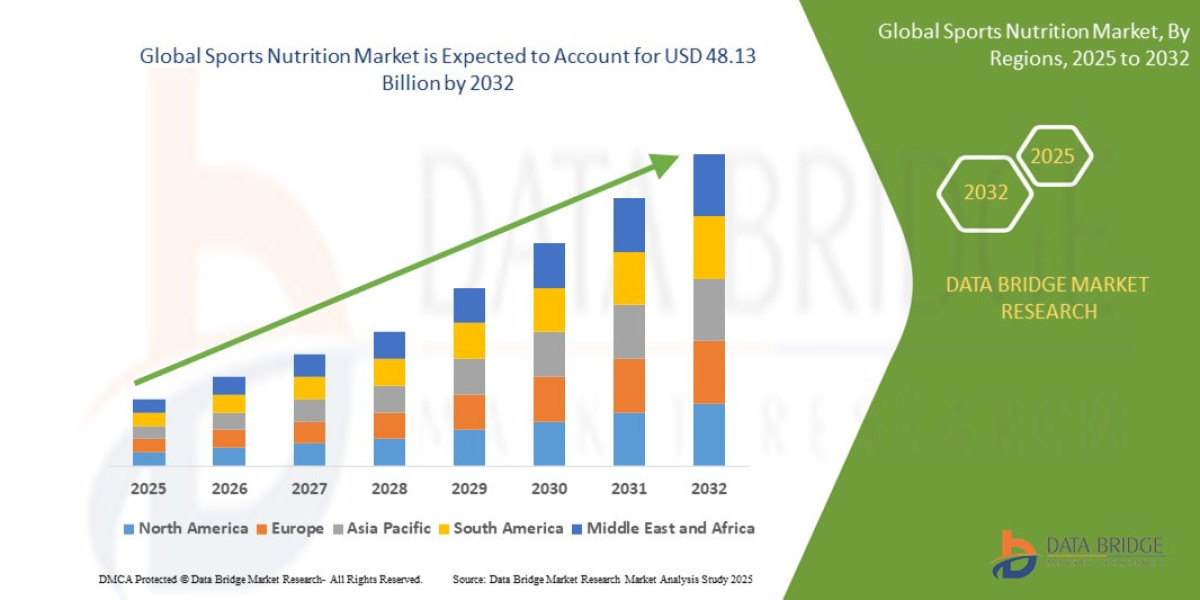Introduction
The sports nutrition market has transformed from a niche category targeting elite athletes to a mainstream global industry appealing to fitness enthusiasts, recreational exercisers, and health-conscious consumers. With the rising emphasis on physical wellness, active lifestyles, and preventive healthcare, sports nutrition products—ranging from protein powders and energy bars to hydration drinks and recovery supplements—have become a staple for millions worldwide.
Globally, the market has gained momentum due to increased gym memberships, the popularity of home workouts, and a growing awareness of how nutrition enhances performance and recovery. Once confined to gyms and specialty stores, sports nutrition products are now readily available across supermarkets, online platforms, and even convenience stores, making them accessible to a broader consumer base.
This report explores the sports nutrition market comprehensively, analyzing its current size, growth drivers, segmentation, competitive landscape, challenges, and emerging trends. It also highlights the future outlook, providing insights valuable for manufacturers, investors, retailers, and policymakers who seek to understand this dynamic industry.
Source - https://www.databridgemarketresearch.com/reports/global-sports-nutrition-market
Market Overview
The sports nutrition market refers to the category of dietary supplements, functional foods, and beverages designed to improve athletic performance, enhance recovery, and support active lifestyles. Traditionally aimed at athletes, the market has expanded to include recreational users, aging populations focused on mobility, and everyday consumers seeking healthier dietary options.
Historically, the industry’s growth was driven by protein powders and energy drinks. However, in the last decade, consumer demand has diversified to include plant-based alternatives, ready-to-drink shakes, functional snacks, and products fortified with natural ingredients.
According to industry estimates, the global sports nutrition market was valued at over USD 45 billion in 2024 and is projected to grow at a compound annual growth rate (CAGR) of around 8–10% through 2030, potentially surpassing USD 80 billion. North America continues to dominate due to its established fitness culture and strong retail presence, but Asia-Pacific and Europe are experiencing rapid adoption driven by urbanization, rising disposable incomes, and lifestyle shifts.
The market landscape today is defined by innovation, digital sales growth, and a blurring line between sports nutrition and mainstream health foods.
Market Drivers and Opportunities
Several key drivers are fueling the rapid growth of the sports nutrition market:
Rising Health and Fitness Awareness – Consumers increasingly prioritize wellness and preventive health, leading to higher adoption of protein-enriched foods and supplements.
Expanding Consumer Base – The market is no longer limited to bodybuilders or professional athletes. Women, seniors, and casual exercisers are now significant consumers.
Shift Toward Plant-Based and Natural Ingredients – Demand for vegan protein powders, organic energy bars, and clean-label hydration products is surging.
E-commerce Growth – Online platforms allow brands to reach global consumers directly, with personalized marketing and subscription models boosting sales.
Innovation and Product Diversification – Companies are introducing multifunctional products, such as protein chips, collagen-enriched beverages, and ready-to-drink recovery shakes.
Future Opportunities
Personalized Nutrition: The integration of wearable devices and AI-driven diet recommendations will create opportunities for customized sports nutrition plans.
Emerging Markets: Rapid fitness adoption in countries like India, China, and Brazil provides untapped potential.
Functional Crossovers: Combining sports nutrition with beauty (nutricosmetics), mental health (nootropics), and immune support could expand consumer appeal.
Market Challenges and Restraints
Despite robust growth, the sports nutrition industry faces several challenges:
Regulatory Complexity – Supplement regulations vary widely across regions. Inconsistent labeling standards and claims restrictions can limit product launches.
High Competition and Price Pressure – Established brands face intense competition from startups and private-label retailers offering cost-effective alternatives.
Ingredient Sourcing and Supply Chain Issues – Dependence on raw materials like whey protein and plant-based isolates creates risks related to price volatility and sustainability concerns.
Consumer Skepticism – Misleading claims, product recalls, and safety concerns have made some consumers cautious about supplements.
Economic Uncertainty – Inflation and reduced discretionary spending in some regions may slow premium product purchases.
If these challenges are not addressed, market players risk losing consumer trust and long-term growth opportunities.
Market Segmentation Analysis
By Product Type
Protein Powders and Supplements: The largest category, driven by bodybuilding, recovery needs, and lifestyle protein consumption.
Sports Drinks: Widely used for hydration during endurance activities. Functional beverages with electrolytes and natural ingredients are growing.
Energy and Nutrition Bars: Convenient snacks for on-the-go consumers; demand for low-sugar, high-protein options is strong.
Other Supplements: Creatine, BCAAs, pre-workouts, and joint-support products cater to niche performance needs.
By End-User Application
Athletes and Bodybuilders: Traditional core users focused on performance.
Recreational Fitness Enthusiasts: Fastest-growing segment due to rising gym culture and home fitness.
Lifestyle Users: Consumers integrating sports nutrition into everyday wellness routines.
By Distribution Channel
Supermarkets/Hypermarkets: Expanding shelf space for sports nutrition products.
Specialty Stores: Gyms, health stores, and nutrition shops remain important for expert advice.
Online/E-commerce: Fastest-growing channel due to convenience, reviews, and wide product variety.
Pharmacies: Increasing role in providing clinical-grade supplements.
By Region
North America: Dominant market with mature demand.
Europe: Strong adoption of clean-label and plant-based sports nutrition.
Asia-Pacific: Fastest growth, driven by rising middle class and expanding fitness industry.
Latin America & Middle East: Emerging opportunities in urban areas with growing fitness culture.
Currently, protein supplements and online distribution dominate, while Asia-Pacific offers the most promising growth trajectory.
Competitive Landscape
The sports nutrition market is highly competitive, with a mix of multinational corporations, regional brands, and niche startups.
Key Players
Glanbia plc (Optimum Nutrition, BSN)
Nestlé S.A. (Muscle Milk, Garden of Life)
PepsiCo (Gatorade, Propel)
Abbott Laboratories (Ensure, EAS)
Clif Bar & Company
The Hut Group (Myprotein)
Strategic Developments
Mergers and Acquisitions: Large food and beverage companies are acquiring niche sports nutrition brands to diversify portfolios.
Product Innovation: Companies are launching plant-based protein powders, low-sugar bars, and collagen-infused drinks.
Digital Marketing: Influencer campaigns, personalized fitness apps, and subscription boxes are boosting brand loyalty.
Sustainability Initiatives: Brands are moving toward recyclable packaging and ethically sourced ingredients to appeal to eco-conscious consumers.
The landscape shows a shift toward direct-to-consumer (D2C) models, which enable companies to build stronger relationships with fitness communities.
Future Outlook and Trends
Over the next 5–10 years, the sports nutrition market is expected to evolve significantly.
Mainstream Integration: Sports nutrition will become part of daily nutrition for wider populations, not just athletes.
Technology-Driven Customization: Genetic testing and AI-based apps will recommend personalized supplement regimens.
Clean Label Movement: Transparency, natural formulations, and allergen-free products will dominate.
Sustainable and Ethical Practices: Plant-based proteins, regenerative agriculture, and eco-friendly packaging will gain traction.
Regional Growth: Asia-Pacific is projected to experience double-digit CAGR, making it the most lucrative growth hub.
By 2030, the market is expected to surpass USD 80 billion, with innovation and inclusivity shaping its future.
Conclusion
The sports nutrition market is undergoing a paradigm shift from a niche, athlete-driven sector to a mainstream health and wellness industry. Fueled by growing fitness awareness, product innovation, and digital transformation, the market holds immense potential across regions and consumer groups.
While challenges like regulation and competition persist, opportunities in personalization, plant-based nutrition, and e-commerce will define the future. For stakeholders, investing in innovation, transparency, and consumer engagement will be crucial to capturing long-term growth.
The sports nutrition market is not just about supplements—it is becoming a central pillar of global health and wellness.
Frequently Asked Questions (FAQ)
1. What is the current size of the sports nutrition market?
As of 2024, the global sports nutrition market is valued at over USD 45 billion. It is projected to grow at a CAGR of 8–10% through 2030, potentially reaching USD 80 billion or more.
2. What are the key drivers influencing growth in this market?
The market is driven by rising fitness awareness, an expanding consumer base beyond athletes, demand for plant-based and clean-label products, and the rapid growth of e-commerce.
3. Which regions dominate the sports nutrition market?
North America currently leads due to its strong fitness culture and mature retail channels. However, Asia-Pacific is the fastest-growing region, fueled by urbanization, rising disposable incomes, and increasing adoption of active lifestyles.
4. Who are the major players in the industry?
Leading players include Glanbia plc, Nestlé S.A., PepsiCo, Abbott Laboratories, Clif Bar & Company, and The Hut Group (Myprotein). Startups focusing on vegan and functional nutrition are also gaining traction.
5. What are the latest trends shaping the future of this market?
Key trends include plant-based protein innovations, personalized nutrition solutions, eco-friendly packaging, functional crossovers (e.g., beauty and wellness), and increased online sales through direct-to-consumer platforms.
6. What challenges could slow down growth in this sector?
Challenges include regulatory inconsistencies, supply chain disruptions, high competition, consumer skepticism about product claims, and economic pressures affecting discretionary spending.
7. How can businesses benefit from investing in the sports nutrition market?
Businesses can benefit by tapping into emerging markets, investing in product innovation, adopting sustainable practices, and leveraging e-commerce and digital engagement to reach a broader customer base.
Browse More Reports:
Global Fleet Management Market
Global Digital Banking Market
Global Perfume Market
Global Pro AV (Audio-Visual) Market
Global Business Process Outsourcing (BPO) Market
Saudi Arabia Fleet Management Market
Global Alcoholic Beverages Market
Global Healthy Snacks Market
India Business Process Outsourcing (BPO) Market
Global Edible Cutlery Market
Global Manufacturing Execution System (MES) Market
Global Veterinary Medicine Market
Europe Business Process Outsourcing (BPO) Market
Global Biofuels Market
Global Craft Beer Market
Global Recreational Vehicle (RV) Awnings Market
Global Shisha Tobacco Market
Global Sports Nutrition Market
Global D-limonene Market
Global Essential Oils Market
About Data Bridge Market Research:
An absolute way to forecast what the future holds is to comprehend the trend today!
Data Bridge Market Research set forth itself as an unconventional and neoteric market research and consulting firm with an unparalleled level of resilience and integrated approaches. We are determined to unearth the best market opportunities and foster efficient information for your business to thrive in the market. Data Bridge endeavors to provide appropriate solutions to the complex business challenges and initiates an effortless decision-making process. Data Bridge is an aftermath of sheer wisdom and experience which was formulated and framed in the year 2015 in Pune.
Contact Us:
Data Bridge Market Research
US: +1 614 591 3140
UK: +44 845 154 9652
APAC : +653 1251 975
Email:- corporatesales@databridgemarketresearch.com








